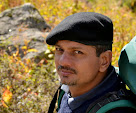For the Hindu devout, Gangotri is one of the four dhams which guarantee a ticket to heaven (the other three being Yamunotri, Badrinath and Kedarnath). Adventurists, irrespective of their religious loyalties, think so too. For, this picturesque spot in the Garhwal Himalayas offers endless divine pleasures — call it heaven, if you so wish. So Amit, Gautam and I set out to this heavenly abode one fine April morning in my second-hand Maruti 800. This was going to be my first formal trek (wayback in 1995).
The route to Gangotri, Hrishikesh onward, offers an ideal sideway sighting. The beauty gets better after Ganganani, a hot water spring. This natural sulphar spring (or tapt kund), has two separate public bath pools for men and women. From here to Harsil, the last stoppale spot before Gangotri, high mountains behold tricky turns. Any driving daredevilry here might buy you your ticket to heaven, literally. We nearly booked our seats when I decided to save petrol on a downhill stretch and my tyres skidded to the edge of a cliff. I felt the sweat down to my undies.
But by Harsil, we had put the bad experience behind us and pitched a tent (borrowed from Wilson John) near a roadside dhaba and a clear water stream. One full day can be spent at Harsil, visiting the winter seat of goddess Gangotri at one side of the road or take a hike to Saat-Taal (literally, seven ponds but there are only four here) on the opposite side. One of these ponds has a thick growth of carpet grass where you can jump and spring, like a water bed. The final and the fourth taal can tempt you with a swim but unless you are sure you won't cramp your muscle in the cold waters, don't jump.
The route from Harsil valley to Gangotri costs about an hour and pays lush greenery in return. A recurring problem was toll tax barriers at various turnarounds. We kept tossing the tenner/fivers to see the barrier poles go up in the air. In the festive season, Gangotri can put you off with its human activity. It mainly hosts the historic temple, a few ashrams and a makeshift bazaar of copperware, pooja items, prasaad and eateries. If you are not the religious type, there is no use hankering around the temple. Choose yourself a spot that allows a prime view of the noisy Ganga negotiating large boulders. Another whole day can be spent lying there straightening the limbs. But Gangotri is no longer the real birthplace of the holy river. Gaumukh, the glacier from where it originates, has over past several decades shifted backwards. It was a good idea to brace the backpack and reach Gaumukh from where Ganga actually melts into life. We divided the itinerary in two days for comfort sake (Today it would be just an eight-hour walk for me). On the way, glowing peaks, bluer sky, large tracts of birch-pine forests and a few blue water ponds reminded us of calender art.
The last dhaba before Gaumukh is Bhojbasa where you get maggie, dal-chawal and a breathtaking view of three peaks — Gangotri One, Two and Three. Gaumukh is barely two-km light walk from here. At Gaumukh, there is a burphani baba (snow saint) hutment nestled between two large boulders and covered by a canvas sheet; if you have nothing to eat, he may help you with some khichdi for dinner. It beats logic as to why the good man is coming here for years and torturing himself to boredom, but hills are like that: an onion full of mysteries, peel over peels. Doctor’s advice is to think less, see more, walk hard, eat well and drink not (at high altitudes, lack of oxygen makes drinking more dehydrating and nausea follows). That whole night, it snowed and we kept guard one by one to keep pushing snow mounds depositing over our camp. The day next, when we tried to get some water, we had to break a thin ice crust over the Ganga. Morning ablutions refused to cooperate.
Four km further up from Gaumukh is Tapovan where the nascent form of the Bhagirathi flows in childlike glory. The journey to Tapovan is tiresome thanks to lack of oxygen. Guide will be of help if you have no experience in trekking before. Hire one from Bhojbasa. Tapovan is a meadow (bugyal), with an icy stream slicing it in two large parts. This is also the base camp for the mountaineers to Shivling, a divine peak that stands majestically atop the meadow. If you have proper equipment (like ice axe, ropes et al) you can try and go further down to Nandan Van or Vasuki Tal, via a glacier trek.
We stayed overnight at Bengali baba's ashram in Tapovan. For the want of ice axe, will power and energy, we decided to call it our last stop. Cribbing and crying, we returned to the grime of April in Delhi. The patience, planning, team spirit et al learned during the trek, melted like an icecream in the city heat. But even 11 years after, a faint flavour still lingers in our mouths.
Subscribe to:
Post Comments (Atom)

1 comment:
Great buddy! It's a great idea to write. It will reassure you why you are better than jokers around who think they are God's gift to journalism.
Shall read regularly. I am yet to start. More comments later. But be sure to write regularly.
All the best!
Post a Comment